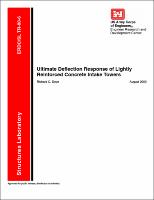Please use this identifier to cite or link to this item:
https://hdl.handle.net/11681/11264| Title: | Ultimate deflection response of lightly reinforced concrete intake towers |
| Authors: | Dove, Richard C. |
| Keywords: | Deflection response Intake towers Hydraulic structures Strain penetration Earthquakes Earthquake effects Seismic response |
| Publisher: | Structures Laboratory (U.S.) Engineer Research and Development Center (U.S.) |
| Series/Report no.: | ERDC/SL TR ; 00-6. |
| Description: | Technical Report Abstract: The overall objective of this research is to understand the nonlinear response of existing, lightly reinforced intake towers. The ultimate objective is the evaluation and/or development of approximate or simplified analysis procedures for the evaluation of the ductility of existing intake towers. There were three phases in the fulfillment of this ultimate objective. The first phase was a statistical analysis of the inventory of existing intake towers. The specific objective of this tower inventory analysis was to quantify the distribution and variation of the structural characteristics of the U.S. Army Corps of Engineers’ inventory of existing intake towers as relating to their earthquake location hazard. This analysis was used to assist in the identification of possible failure mechanisms to help quantify the extent of the problem of the seismic response of existing towers. The information generated was used in planning the second phase of this research effort, the Intake Tower Substructure (ITS) experimentation series conducted in 1996 and 1997. The objectives of these experiments were to observe the response of scale models of typical intake towers, quantify the ductility available, and use the information generated for the development of approximate and/or simplified analysis procedures for the evaluation of the ductility of existing intake towers. The most important finding was that the crack width in the failure zone is largely controlled by the steel rupture strain. Steel rupture strain is well understood and usually easy to obtain. In summary, we now have a deflection-based analysis procedure. However, the rotational spring model needs further development and the procedure must be verified for dynamic response and perhaps for larger bar sizes. It is recommended that further experimental and analytical work address these concerns. This experimental effort successfully generated a substantial amount of data on the strain penetration/failure deflection characteristics of the reinforcing steel in the failure zone of lightly reinforced intake towers. The subsequent analysis of the data provided information on the rotational capacity of the critical section at the base of the tower and hence to an estimation of the ultimate deflection capacity of existing intake towers. An empirical equation was generated for the estimation of the parameters required for this calculation, and the method was successfully applied to an example problem. This fulfills the objectives as initially stated in this report. |
| Rights: | Approved for public release; distribution is unlimited. |
| URI: | http://hdl.handle.net/11681/11264 |
| Appears in Collections: | Technical Report |
